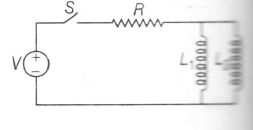Answer:
Option A,B,C
Explanation:

since inductors are connected in parallel
$V_{L_{1}}=V_{L_{2}}$
$L_{1}\frac{dI_{1}}{dt}=L_{2}\frac{dI_{2}}{dt}$
$L_{1}I_{1}=L_{2}I_{2}$
$\frac{I_{1}}{I_{2}}=\frac{L_{2}}{L_{1}}$
Current through resistor at any time t is given by
$I= \frac{V}{R}(1-e^{-\frac{RT}{L}}) where L=\frac{L_{1}L_{2}}{L_{1}+L_{2}}$
after log time $I= \frac{V}{R}$
I1 +I2 =I .........(i)
L1I1 = L2I2 ........(ii)
From eq(i) and (ii) , we get
$I_{1}=\frac{V}{R}\frac{L_{2}}{L_{1}+L_{2}}$, $I_{2}=\frac{V}{R}\frac{L_{1}}{L_{1}+L_{2}}$
(d) value of current is zero at t=0
value of current V/R at t=∞
hence option (d) is incorrect